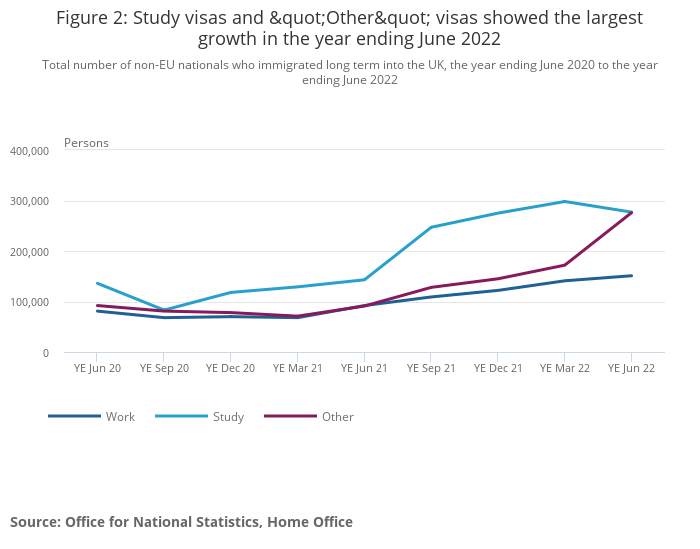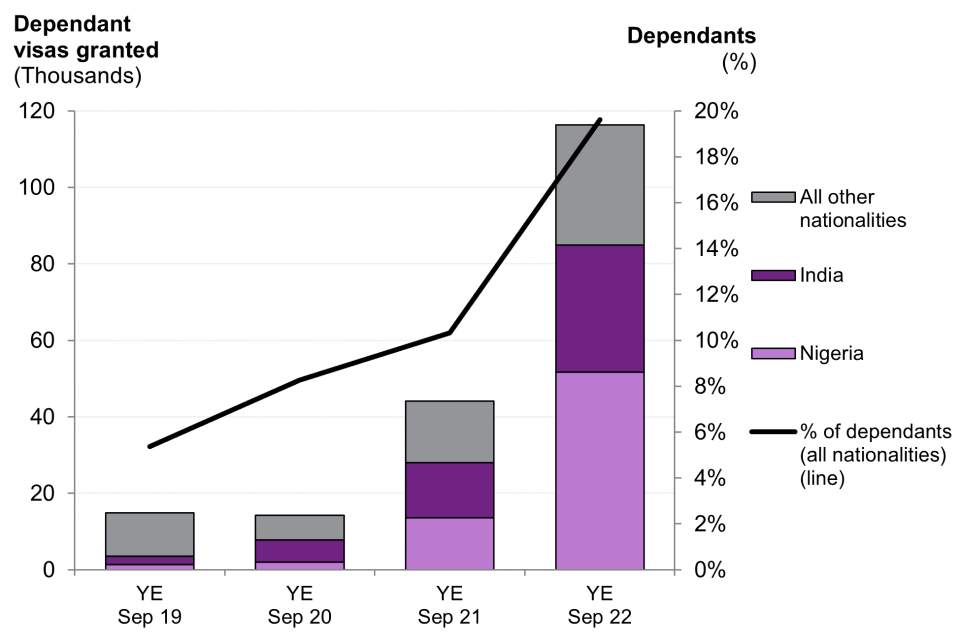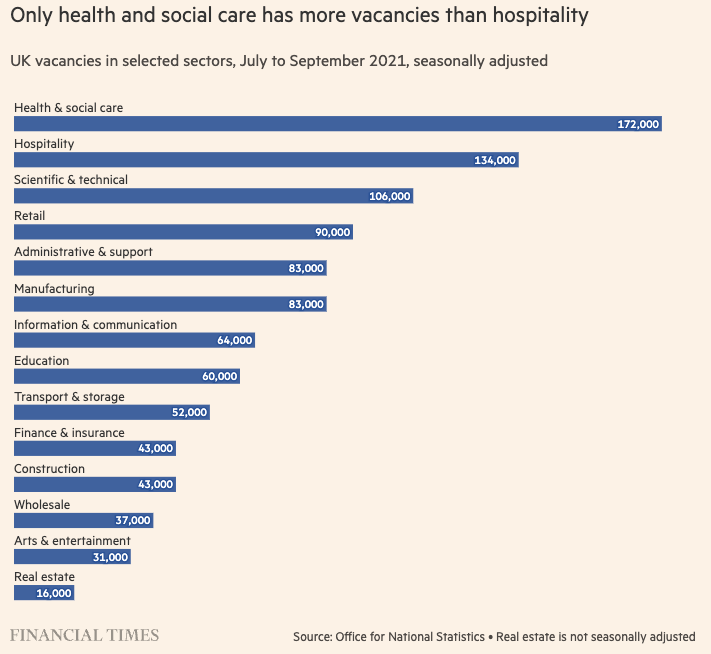In an ideal world, news that the higher education sector is attracting a significant number of students to study in the UK would be great news for a post-Brexit ”global Britain”.
But new figures that show that net migration in YE June 2022 reached over half a million (504,000) – driven to a considerable extent by international students – makes things very uncomfortable in a political environment where immigration appears to have returned as a salient issue both among the electorate and for the current government.
Public First/More in Common polling from earlier this month showed that most Brexit voters (73 per cent) and all voters (57 per cent) now think immigration has increased since Brexit – and most Brexit voters (78 per cent) and all voters (56 per cent) think it is “too high”. Only 30 per cent of all voters think it is “about right” or “too low”.
With a government struggling to hold onto some of its older, immigration-sceptic voters, and economic impact claims that to a significant extent are founded on rent payments for scarce accommodation heating up the housing market, these feel like circumstances ripe for reform.
Today’s papers say – with a line straight from Downing Street – that Suella Braverman’s party conference lines of international students being “barred from studying low quality degrees” and “restricted from bringing their family with them” are both actual plans now being considered to reduce overall immigration.
Impacts and costs
Before we try to work out what the implications could be, the figures do deserve some unpacking – and we have a lot here, both from the Home Office, which counts and issues figures on the numbers of visas it issues, and the Office for National Statistics (ONS) which attempts to tot up those entering and leaving to give us a net figure for the population.

In the net migration release, ONS reminds us that the period leading up to June 2022 was pretty unique – with various factors coinciding to impact long-term immigration like a recovery in travel following pandemic, the still ongoing support for Ukrainian nationals and others requiring protection, and a new immigration system following transition from the EU.
ONS’ Director of the Centre for International Migration puts it like this:
Migration from non-EU countries, specifically students, is driving this rise. With the lifting of travel restrictions in 2021, more students arrived in the UK after studying remotely during the coronavirus pandemic. However, there has also been a large increase in the number of people migrating for a range of other reasons. This includes people arriving for humanitarian protections, such as those coming from Ukraine, as well as for family reasons.”
In the year ending YE June 2022, those arriving on study visas accounted for the largest proportion (39 per cent) of long-term immigration of non-EU nationals at 277,000 – an almost doubling of the figure of 143,000 in the YE June 2021. ONS reckons that it is at least possible that the lifting of travel restrictions in 2021 has meant more students arriving in the UK for their studies after studying remotely during the pandemic.
But it also speculates that the increase may well be about students being attracted by the introduction of the Graduate Route visa in Summer 2021. We don’t yet know how many students will take up the route, how long they’ll stay for, and whether they’ll attempt to jump onto skilled worker visas at some stage – but ONS’ note that 61 per cent of non-EU students left at the end of their study visa in the academic year ending 2019 almost certainly underplays the extent to which the increase in entrants is likely to have been driven by those fully intending to take up the new route.
Do they stay or do they go?
The Home Office figures are more helpful. They tell us that in the year ending June 2022, the number of “visa extensions” granted in the new Graduate category was 66,211 – which is almost bang on the “central estimate” in the Home Office’s impact assessment of the points-based system (of which the graduate route is a part) back in 2021.
So what’s the problem? In that assessment – which as we’ve covered before, doesn’t do anything on the changing geographical distribution (and differential community impact) of its net numbers guesswork – the “central estimate” for YE June 2022 was that just over 30,000 more students would arrive each year in comparison to 2019.
The great news – or massive problem, depending on how you look at it – is that just before the pandemic, the Home Office issued just shy of 240k Tier 4 visas. When you smooth out 2020 and 2021, that was broadly consistent, albeit causing a bit of bulge via the backloading into 2021. But for the year ending September 2022 we’re now on 462,660 – about 200,000 more than the Home Office guess. And that’s before any increase we’ll get via the January intake.
On one level, the right thing to do would be to say to the kneejerkers – this will level off. When you (re)introduce the graduate route and make it two years (three for PhD), during those initial two years you get a net increase because people who usually have left haven’t yet. A good chunk of those that jumped on the graduate route in 2021 will leave in Summer 2023.
But two factors confound that kind of sensible argument. The first is the apparently astonishing attractiveness of the route to new entrants. And the second is what we know to be a bugbear of Home Secretary Suella Braverman – dependants.
Meet the parents
That attractiveness issue coupled with a need to make budgets add up implies a general tension that we’ve explored before between margin/surplus, and both revenue and investment spend to ensure that you can cope with the extra numbers in general.
There are then debates about integration (in a sector that still thinks it’s doing assimilation in the name of “soft power”), long-term dependency on the money, and the management of population growth in general – all of which should be familiar to Wonkhe readers.
But on that dependants issue, whatever your perspective, this is an astonishing chart. In the YE September 2022, a fifth of sponsored study visas were issued to family members of students – compared to just 6 per cent 2019. Nobody planned for this.

The Home Office quietly says this may in part “reflect a change in composition of students, if for example there are a greater number of older students attracted to study in the UK” – and so if the increase is largely in international PGT, that would make a slither of sense.
But this is much more likely to be about where we are recruiting from. Nigeria had the highest number of dependants (51,648) in September 2022, increasing from 1,586 in 2019. Indian nationals had the second highest number of dependants, increasing from 3,135 to 33,239. Visas issued for the top 5 nationalities student dependants (Nigeria, India, Pakistan, Bangladesh and Sri Lanka) were over 100,000 for the year ending September 2022.
If you take Nigeria as an example, the average age at which women have their first child in Nigeria is 20.4 – it’s 29.6 in the UK. And the average number of births for each mother is 5.61 – it’s 1.7 in UK.
The truth is that students as parents has been declining as a salient policy and infrastructure issue for UK higher education as the average age of UGs has gone down, and the age at which people become parents has gone up.
But the moment you decide to recruit large numbers of students from another country, the wise thing is to think about the educational, health and social needs that those students are likely to have – and intervene to ensure that there is the right infrastructure to support, both on campus and out in the community.
Yet while the numbers make it very obvious that there is now a major structural need for support for students as parents, support for students that are pregnant, a need for childcare both on and off campus, major timetabling implications and a huge need for family accommodation – it’s not clear that the graph above and its local versions has been anything other than a surprise to much of the sector.
How many governing bodies have the financials of a drop in international recruitment on their risk register? How many analyse the needs of cohorts of students and identify the risks of the university or the community not meeting their needs?
And so what should be a moment for popping corks suddenly looks like a problem with planning – a sector vulnerable to the allegation that it is using international students as cash cows without properly planning for their needs. An updated version of 2009’s Meet the Parents with an international perspective is now already long overdue.
Housing a crisis
But next you have to think about the intersection with housing in a country which loves its Harry Potter boarding school model. If nothing else, even if you kid yourself that the UK’s student cities have been able to absorb the general increase in demand for bedspaces implied by the overall figures (rather than simply shifting students further from campus), if you consider the likelihood of most cities’ housing stock being able to accommodate dependants, you quickly realise why locally, a lot of folk are muttering about a student family housing crisis.
Homeless families are like that – 50 single 18 year olds doing a bit of bunking up or sleeping in the library in the 90s was often not noticed, but 50 families with small children still in Airbnbs by late November 2022 really is a different story.
And when you add the cost of living crisis – which anecdotally appears to be causing significant proportions of students from the growth countries to eschew the posh purpose-built halls that have been hurled up in recent years, and pile on pressure in the private housing market caused by soaring interest rates maxing out landlords’ buy-to-let portfolio bills – you suddenly start to think that even without an intervention from Braverman, January’s intake looks very difficult indeed.
As I noted here:
Numbers matter. Last year some 267,807 visas were issued for students and dependents. A year later, that figure was 473,243 – or 549,350 if you include graduate route issuances. No, a reduction in EU doesn’t go near covering the increase. So the first question nationally is how many bedspaces were empty in 20/21, plus how many more bedspaces came on stream in 21/22. I know that figure isn’t 300k. And I doubt that the numbers have fallen for 2022 Q3 issuances, which we’ll get figures on from the home office in a month or so.
We have them now. They haven’t fallen. And even if they now stand still (they can’t unless nobody comes in January, but run with me) the compound impact over 3 years will be profound.
Critical paths
The processes don’t help, which I’ve been trying to map since I covered the family accommodation issue on Wonk Corner a couple of weeks ago. When universities apply for increases in their allocation of CAS (confirmation of acceptance for studies) from UKVI, it’s not clear if that conversation includes an assessment of available housing – and if it does whether that assessment includes required types or price points. It almost certainly should.
Once it has the allocation, a university makes a whole bunch of offers – not knowing if students have dependants. Under the rules for sponsors, a university is then under a compliance obligation to hit a 90 per cent enrolment rate off the CAS allocation.
That creates a direct incentive to not warn students that family accommodation might not be available. And when students apply for dependant visas, the university isn’t told either about the application or the acceptance – which means that the university can’t warn them directly about a lack of family accommodation if it wanted to.
But even if that accommodation issue could somehow be solved, and in many cities it feels like we’re aquaplaning into a new year crisis that it is now too late to avoid, the questions will remain about all the other issues – like quality, facilities, diversity, student support and underpinning campus and academic infrastructure. Things like a rapid increase in academic misconduct allegations that nobody foresaw, or local bus services that can’t cope amid a driver shortage, or GP services that can’t grow as fast as the NHS surcharge income implies it can.
And sadly, the abject failure of regulation to catch, identify and analyse the implications – even where providers’ financial projections implied this kind of success – won’t mean that OfS, HEFCW or the SFC get the blame when things go wrong. It will be universities – and worse, these students.
Solving shortages
I did think last week that the news that there’s a million vacancies in the economy – most of which are in sectors that students tend to work in – offered an opportunity to at least temporarily relax the 20 hour a week term time employment rule.

That’s because there’s barely an international student in the country that will have been properly warned about how expensive the UK is right now, and if we could make the student experience work alongside it, lifting the limit might help those sectors thrive in a way that doesn’t involve adding to the kind of “low-skilled” migration some that both main parties seem opposed to. And the kneejerkers calling for a crackdown ought to stop and think about what a reduction from here in overall numbers would do those vacancy rates too.
But honestly? Once you have net migration over half a million, whatever the truth in the complexity of the figures, all the bets are off. Ideology takes over. “Too many”, my relatives will say around the dinner table at Christmas, pointing to the memes on Facebook. If a stroke of the pen and a yank of the lever can get the numbers down when you’re struggling to control arrivals on boats, I have a very bad feeling about what comes next.
You see, it’s not that 462,660 is “too many”. I’d be happy for it to be a million. I’m all too aware of the benefits that international students bring, and I know that the funding pressures are significant.
It’s that increasing international PGT at the rate and pace that the sector has, in the departments and subjects that it has – all without being sure that the infrastructure that the sector can control and influence can keep up – may prove to be best example in many decades of the odd bit of central planning sometimes being better than uncut, untrammelled marketisation.














“Under the rules for sponsors, a university is then under a compliance obligation to hit a 90 per cent enrolment rate off the CAS allocation.” I’m afraid that this is not true, and even if it were, only tells half the story.
Universities have a compliance obligation to hit 90% enrolment rate off the successful visa applications, not the underlying allocation. And you omit to mention that there is also an 85% completion rate metric imposed by the Home Office. So universities must ensure a minimum number of students START and FINISH.
Far from the “direct incentive to not warn students that family accommodation might not be available” that you falsely infer, I would argue there is a very strong incentive to ensure that the students whom are issued with a CAS are fully aware of what they are signing up for. Because not finishing is just as bad as not starting.